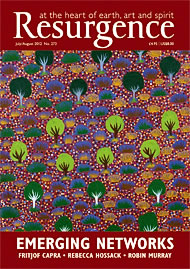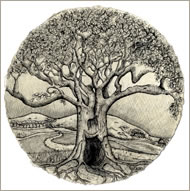It isn’t easy to be original when writing a book about trees, one of the most frequently visited subjects for environmentalists, horticulturists and many others. However, Daniel Butler’s contribution is certainly unusual, not least in the rather unconventional structure and eclectic mix of subject-matter, evidently reflecting the author’s very broad interest in and passion for the subject. A pocket-sized hardback with some beautiful illustrations, this book is a real pleasure to hold in the hand.
In many ways this is a reference book, something to dip into rather than read from start to finish. Nevertheless, there is a narrative journey of sorts. The author takes the reader through a series of commemorative tree-planting occasions, starting from birth and moving through the various stages of life – coming of age, marriage, retirement and bereavement.
Interspersed with these are short descriptions on the characteristics of particular tree species. These are far from exclusively native or commonly found in the UK. So we learn about the oak and the ash but also the ebony and rarities like the Wollemi pine. The book also has practical sections on techniques such as grafting and cloning, as well as short pieces on wildlife in woodlands and using timber responsibly. This variety and interweaving make the book intriguing and distinctive.
At its heart is the author’s real interest in the commemorative role of tree planting, but the book offers so much more. It is in part a beginners’ guide to sylviculture and in part a miscellaneous collection of short pen-portraits of particular trees that appeal to the author, such as the redwood and baobab. I like the fact that this book shuns the divide that so often keeps the scientific and spiritual appreciation of trees separate, and I rather like the idiosyncratic approach that has the reader thinking about how to celebrate an engagement on one page and learning how to grow a bonsai on the next. However much we harvest, study, categorise and prune trees, there is something about them that I suspect will always be essentially wild and ineffable – which is of course a big part of what draws us to them – and Butler’s approach reminds us of that.
As a tree lover, I enjoyed reading this book. Two things would, in my view, have made it even better. The first is an inevitable consequence of addressing such a broad subject in such a short space. I found myself wanting more information all the time – for example, useful though the sections on looking after your tree are, you would be unlikely to rely on them as your sole technical guide. Perhaps some further references would have been useful. I had the feeling of too many things being touched upon or mentioned in passing, with not enough of them being explored sufficiently to satisfy.
Secondly, I wanted a bit more of a narrative, something that linked the different sections of the book together a bit more. Much as I enjoyed leaping from the plum one moment to how to combat climate change the next, I wanted more of a thread to help me make sense of the journey. I wanted to know why I was being told about the bristlecone pine – fascinating though it is – but not the beech, which I am much more likely to plant in my garden.
I’m not suggesting there is no organising personality behind the book’s structure; it’s just that I didn’t feel it speaking to me clearly as I read. Neither of these criticisms should deter you from buying the book. Even if you don’t get around to reading all of it, it is a lovely thing to own or to give and a reminder that physical books can have personalities of their own, quite distinct from the information they contain.








